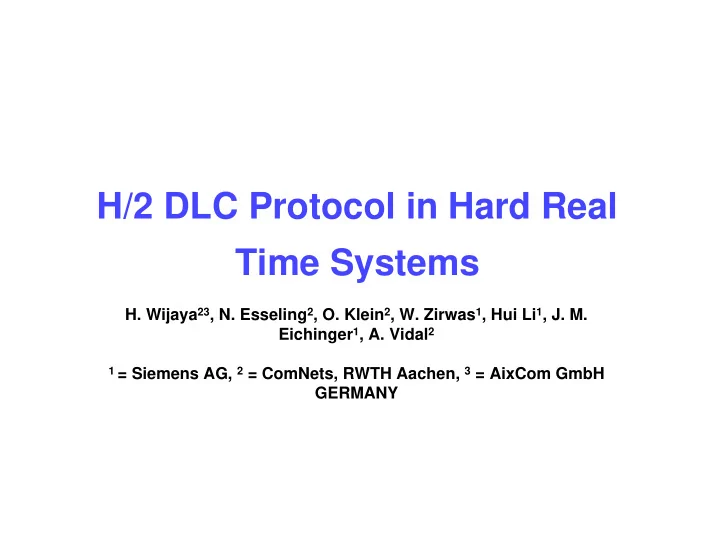

H/2 DLC Protocol in Hard Real Time Systems H. Wijaya 23 , N. Esseling 2 , O. Klein 2 , W. Zirwas 1 , Hui Li 1 , J. M. Eichinger 1 , A. Vidal 2 1 = Siemens AG, 2 = ComNets, RWTH Aachen, 3 = AixCom GmbH GERMANY
COVERAGE � Initiated by Siemens AG � To observe and to develop Multi-Hop networks � The testbed development is shared among TU Hamburg-Harburg, IAF and TU-Dresden, AixCom and RWTH Aachen (ComNets) � To analyse and to optimise new algorithms e.g. for channel estimation, Radio Resource Management, Vertical and Horizontal Handover procedures � To develop a Multi-Hop capability for H/2 using “Forwarder” concepts
Testbed Architecture • The H/2 Data Link Control Protocol (DLC) is formally specified using Specification and Description Language (SDL) • Modem Interface Software (MIS) is responsible to handle the IRQs and Memory Mapping • Rosa Box is responsible for Tx and Rx timing / synchronization purpose •Time critical processes
Timing in Mobile Station MAC
Timing in Acces Point MAC
Time Critical DLC Processing
H/2 DLC Specification in SDL
Problems in DLC Development SDL is easy and good to use for specifying communication protocols but ... � The execution time of „standard“ SDL specification is very slow � SDL is not best suited for Hard Real Time system !! � It is very difficult to program an interface that works well with both SDL data structures and hardware data structures (MIS) � SDL cannot provide a good Software Abstraction Level for Modem Interface Software (MIS) !! � The „standard“ SDL executable from SDT Telelogic Tau is a user application � SDL introduces extremely high delay and the concept of device driver programming is violated !!
DLC Development in RT System Therefore � Introduce C pointer into the SDL specification � Introduce C data structures which work perfectly in both SDL and hardware interface environments (MIS) � Linux supports only „Round Robin“ scheduling � SDL protocol has the same priority as the mouse protocol � Real Time Linux supports „Priority“ Scheduling � Development of some new SDL Kernels which enable the SDL specification to run as Real Time Linux module � Compile and link the SDL specification and the SDL Kernel together as RT Linux Module and assign a high priority to it
H2 Device Driver
SDL in Real Time Kernel (Soft Real Time approach) • MIS intercepts IRQs from H/2 modem board and writes a message into the IPC queue • The SDL Kernel (SCT World) wakes up periodically to poll the ENV • The ENVironment (ENV) checks the IPC queue if there is a message • Then the ENV will contact SDL (Sys) after processing the message from IPC queue
SDL in Real Time Kernel (Hard Real Time approach) • MIS intercepts IRQs and triggers the SDL Kernel on by sending „ON“ signal through IPC and writes a message into the IPC queue • The ENV checks the IPC queue if there is a message •Then the ENV will contact SDL (Sys) after processing the message from IPC queue • The ENV, triggers the SDT Kernel off by sending „OFF“ signal through IPC
Summary � The objectives of COVERAGE project � To observe and to develop Multi-Hop networks � Multi-Hop for H/2 using “Forwarder” concepts � Development of H/2 Data Link Control (DLC) in SDL � Development of some new Soft and Hard Real Time SDL Kernels � Development of Hard Real Time H/2 device driver
Recommend
More recommend